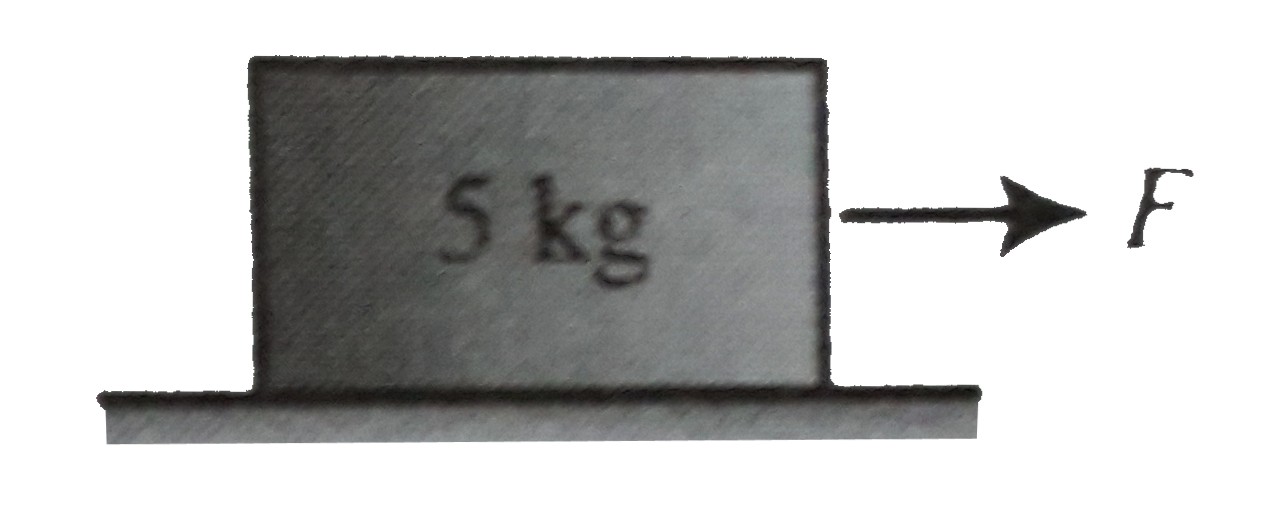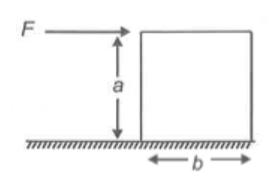A20 kg block is initally at rest. A 75 N force is required to set the block in motion. After the motion starts, a force of 60 N is required to keep the block moving with constant speed. The coefficient of static friction is
0.62
0.52
0.44
0.375
The correct Answer is:D
To find the coefficient of static friction (μs) for the given problem, we can follow these steps:
Step 1: Identify the forces acting on the block
The block has a weight (W) acting downwards, which is given by the formula:
W=mg
where m=20kg (mass of the block) and g=10m/s2 (acceleration due to gravity).
Step 2: Calculate the weight of the block
Substituting the values:
W=20kg×10m/s2=200N
Step 3: Determine the normal force
Since the block is resting on a horizontal surface and there are no vertical forces other than its weight and the normal force, the normal force (N) is equal to the weight of the block:
N=W=200N
Step 4: Relate the static friction force to the applied force
The maximum static friction force (fs) that can act on the block before it starts moving is given as 75 N. This can be expressed using the coefficient of static friction:
fs=μs⋅N
Substituting the known values:
75N=μs⋅200N
Step 5: Solve for the coefficient of static friction
Rearranging the equation to find μs:
μs=75N200N=0.375
Conclusion
The coefficient of static friction (μs) is:
μs=0.375
The block has a weight (W) acting downwards, which is given by the formula:
W=mg
where m=20kg (mass of the block) and g=10m/s2 (acceleration due to gravity).
Substituting the values:
W=20kg×10m/s2=200N
Since the block is resting on a horizontal surface and there are no vertical forces other than its weight and the normal force, the normal force (N) is equal to the weight of the block:
N=W=200N
The maximum static friction force (fs) that can act on the block before it starts moving is given as 75 N. This can be expressed using the coefficient of static friction:
fs=μs⋅N
Substituting the known values:
75N=μs⋅200N
Rearranging the equation to find μs:
μs=75N200N=0.375
The coefficient of static friction (μs) is:
μs=0.375
Topper's Solved these Questions
- LAWS OF MOTIONBOOK - AAKASH INSTITUTE ENGLISHCHAPTER - LAWS OF MOTIONEXERCISE - ASSIGNMENT ( SECTION -B) objective type questions (one option is correct)
59 Videos
- LAWS OF MOTIONBOOK - AAKASH INSTITUTE ENGLISHCHAPTER - LAWS OF MOTIONEXERCISE - ASSIGNMENT ( SECTION -C) objective type questions (More than one options are correct)
21 Videos
- LAWS OF MOTIONBOOK - AAKASH INSTITUTE ENGLISHCHAPTER - LAWS OF MOTIONEXERCISE - TRY YOURSELF
69 Videos
- KINETIC THEORYBOOK - AAKASH INSTITUTE ENGLISHCHAPTER - KINETIC THEORYEXERCISE - EXERCISE (ASSIGNMENT) SECTION - D Assertion - Reason Type Questions
10 Videos
- MAGNETISM AND MATTER BOOK - AAKASH INSTITUTE ENGLISHCHAPTER - MAGNETISM AND MATTER EXERCISE - ASSIGNMENT (SECTION D)
26 Videos
Similar Questions
Minimum force F required to move the block
View SolutionA body of mass 25 kg is at rest on a horizontal surface. Minimum horizontal force required to just start motion is 73.5N and a force of 49N is needed to keep the body moving with a constant velocity. What is the coefficient of (i) static friction and (ii) kinetic friction ?
View Solution
Knowledge Check
A 20 kg block is initially at rest. A 75 N force is required to set the block in motion. After the motion a force of 60 N is applied to keep the block moving with constant speed. The coefficient of static friction is
A0.6B0.52C0.44D0.35
A block of mass 5kg rests on a rough horizontal surface. It is found that a force of 10N is required to make the block just move However , once the motion begains, a force of only 8N is enough to maintain the motion find the coefficient of kinetic and static friction between the block and the horizontal surface

View SolutionA block of mass 5kg rests on a rough horizontal surface. It is found that a force of 10N is required to make the block just move However , once the motion begains, a force of only 8N is enough to maintain the motion find the coefficient of kinetic and static friction between the block and the horizontal surface

View Solution
Three blocks are connected as shown in the figure. Valculate the minimum force required to move the body with constant velocity. The coefficient of friction at all surfaces is 0.25.
View SolutionA horizontal force of 1N is needed to keep a block of mass 0.25kg sliding on a horizontal surface with a constant speed. Find the coefficient of sliding friction. (g=10ms−2)
View Solutionforce F is applied at the topmost point of block of mass M. The force required to topple the block before sliding is (µ = coefficient of friction)

View SolutionA force of 49 N just able to move a block of wood weighing 10 kg on a rough horizontal surface , then coefficient of friction is
View SolutionA horizontal force of 20 N is applied to a block of mass 4 kg resting on a rough horizontal table. If the block does not move on the table, how much frictional force the table is applying on the block. What can be said about the coefficient of static friction between the block and the table? Takeg=10ms2.
View Solution
